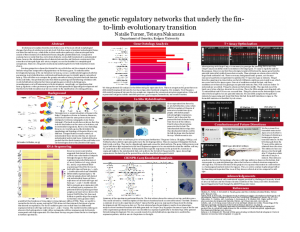Turner, Natalie: Revealing the Genetic Regulatory Networks that Underly the Fin-to-limb Evolutionary Transition
Title: Revealing the Genetic Regulatory Networks that Underly the Fin-to-limb Evolutionary Transition
Name: Natalie Turner
Major: Genetics
School affiliation: Douglass Residential College, School of Arts and Sciences
Programs: Aresty – Research or Conference Funding Recipient
Other contributors: Tetsuya Nakamura
Abstract: The fin-to-limb evolutionary transition is one of the most critical morphological changes that allowed vertebrates to invade land. Anatomical studies have revealed that fins evolved into limbs by a ratio shift from dermal to endochondral bones, which differ in their ossification strategy. Fish fins consist of a proximal domain of endochondral bones and a distal domain of dermal bones, whereas tetrapod limbs consist of three domains of endochondral bones. The autopod is the most distal domain of the tetrapod limb and has controversial origins due to lack of obvious structural similarities with any region of the paired fish fins. Although morphological changes between fins and limbs are well-documented in the fossil record, the genetic mechanisms through which this transition occurred remain elusive.
Previous groups have shown that dermal fin rays of fish fins and the autopod of tetrapod limbs develop from comparable cell populations via the Hoxa13 gene. To understand the developmental process of fin ray formation via Hoxa13, we use a combinatorial approach of RNA-sequencing, in situ hybridization, and functional knockout assay to identify genetic networks of Hoxa13. This will allow us to compare the genetic networks of Hoxa13 between the distal domains of fins and limbs. Our preliminary data from RNA-sequencing and the following validation with in situ hybridization indicates that Hoxa13 regulates genes related to skeletogenesis, musculogenesis, and cell homeostasis in fin development. Accordingly, we hypothesize that Hoxa13 regulates a wide spectrum of genes that are indispensable for appendage development and that the fin-to-limb transition may have occurred via the modification of existing pathways.
